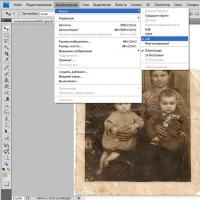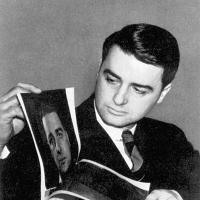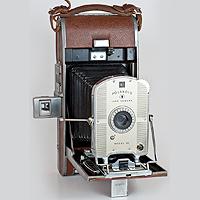Presentation of electroscope conductors and dielectrics electric field. Electroscope. Electric field. Comparison of field and substance properties
Lesson for 8th grade students.
The purpose of the lesson:
To acquaint children with the new device and its purpose;
Give the concept of conductors and non-conductors of electricity;
Education of discipline, accuracy of writing in a notebook, attentiveness.
Formation of a scientific worldview: the world is cognizable, natural phenomena obey physical laws.
Development of thinking and memory;
Ability to speak correctly.
Download:
Preview:
8th grade.
Electroscope. Conductors and non-conductors of electricity. Electric field.
The purpose of the lesson:
To acquaint children with the new device and its purpose;
Give the concept of conductors and non-conductors of electricity;
Education of discipline, accuracy of writing in a notebook, attentiveness.
Formation of a scientific worldview: the world is cognizable, natural phenomena obey physical laws.
Development of thinking and memory;
Ability to speak correctly.
Tasks:
Educational:to reveal the property of substances - electrical conductivity; to familiarize with the use of conductors and dielectrics in practice; to reveal the principle of operation of the electroscope.
Educational: creation of situations of independent search for solutions to the assigned tasks; fostering a respectful attitude towards the opinion of another person.
Developing: development of logical thinking; development of cognitive interest.
Lesson form: work with the text of the textbook, group forms: work
(in pairs), independent work, experimental research.
Teaching method: system search.
Lesson location: intermediate: the lesson can be conducted after studying the concept of "electric charge" and the interaction of electric charges.
Equipment for the lesson:
1 demonstration electrometer, glass and ebonite sticks, a set of minerals, a computer, a multimedia projector.
A single collection of digital educational resources (http://school-collection.edu.ru/)
Video "How to set the sign of the electroscope charge"
Video "Negative charge of the electrometer"
Lesson plan.
- Organizing time.
- Knowledge update.
- Historical excursion.
- Learning new material.
- Consolidation of knowledge.
- Learning new material.
- Consolidation and correction of knowledge.
- Lesson summary, homework.
During the classes:
1. Organizational moment.
Greetings, readiness for the lesson.
2. Actualization of knowledge.
In the last lesson, you and I studied the topic: “Electrification of bodies upon contact. Interaction of charged bodies. Two kinds of charges. At home, you had to repeat it.
(slide 1)
1. What can be said about a body if it attracts other bodies?
A body that can attract other bodies is said to be electrified.
2. What else do they say about the body, if it is electrified?
That the body is given an electric charge.
3. How many bodies can participate in electrification?
Only two bodies can participate in electrification.
4. Is it possible to transfer an electric charge from one body to another, if so how?
An electrical charge can be transferred from one body to another by touching a charged body to an uncharged one.
5. Are bodies with charges of the same kind attracted or repelled?
Bodies with charges of the same kind repel.
6. Are bodies with charges of different kinds attracted or repelled?
Bodies with charges of the same kind attract.
7. How many kinds of electric charges do you know?
There are only two kinds of charges.
8. Name them.
Positive and negative
9. How do charges mean in diagrams, drawings and drawings?
The positive sign "+" and the negative sign "-".
Verification work.
Individual work in the form of a test. It is performed in writing on small format sheets.
3. Learning new material.
Today in the lesson we will get acquainted with the electroscope, its purpose and device, as well as with conductors and non-conductors of electricity.
(slide 2)
“Write the number and topic of the lesson” (written on the chalkboard).
So, we already know that electrified bodies are attracted or repelled, by the interaction it is possible to judge whether an electric charge is imparted to the body. Therefore, the device design, with the help of which it is determined whether the body is electrified, is based on the interaction of charged bodies. (An electroscope is placed on the table) This device is called electroscope , from Greek words ELECTRON , you know how this word is translated from a vulgar lecture, and with cope about - to observe, to discover.
(slide 3)
Write this definition in a notebook.
I have a school electroscope on my desk, look closely at it through a plastic stopper inserted into a metal frame, a metal rod is passed, at the end of which there are two sheets of thin paper, the frame is covered with glass on all sides. Write in a notebook thatan electroscope consists of:
1. Plastic cork;
2. Metal frame;
3. Metal bar;
4. Two pieces of thin paper;
5. Two glasses.
(I lightly rub the ebony stick on the fur and touch it to the metal rod of the electroscope.)
1. Look, the petals of the electroscope have spread out at a certain angle.
(I rub the ebony stick harder on the fur and touch it to the metal rod of the electroscope without discharging it.)
2. Look, the petals of the electroscope have diverged to a greater angle.
Hence, we can conclude thatby the change in the angle of divergence of the leaves of the electroscope, one can judge whether its charge has increased or decreased.
(slide 4)
We have considered with you one of the types of electroscope, where the leaves are the indicator of the electrification of the body. There is another type of electroscope, where the indicator of the electrification of the body is a light metal arrow. In it, the arrow deviates at a certain angle from the charged metal rod.
Now I will touch the electroscope with my hand. Let's see what happens to the petals. (I touch the rod of the electroscope with my hand.) Look, the petals of the electroscope have dropped, so it is discharged.
This will happen with any charged body that we touch. Electric charges will transfer to our body and through it can go into the ground. A charged body will also be discharged if it is connected to the ground with a metal object, for example, an iron or copper wire.
Let's see this by experience:
(slide 5)
1. Take two electroscope. One is charged and the other is not, I connect them with an iron rod. Note that the charge from a charged electroscope flows to an uncharged one.
(slide 6)
2. Also take two electroscope. One is charged and the other is not, I connect them with a long glass rod. Please note that the charge from a charged electroscope does not flow to an uncharged one.
(slide 7)
Conclusion: so, from our experiment, we can conclude that, according to the ability to conduct electric charges, substances are conventionally divided into conductors and non-conductors of electricity. All metals, soil, solutions of salts and acids in water are good conductors of electricity.
Non-conductors of electricity, or dielectrics, include porcelain, ebonite, glass, amber, rubber, silk, nylon, plastics, kerosene, air (gases).
Bodies made of dielectrics are called isolators , from the Greek word isolro - to retire.
5. Primary consolidation of knowledge.
We fill in the table.
(slide 8)
metals, soil, porcelain, ebonite, glass,
salt solutions, amber, rubber, silk,
acids in water nylon, plastics
kerosene, air (gases).
6. The stage of obtaining new knowledge.
The study of the new material is carried out on the basis of a demonstration experiment with two electrometers (electroscopes), on the rods of which there are identical spherical conductors, and on the analysis of its results. I charge one of two identical electrometers and ask the students to answer the question: "What happens if you connect these electrometers with a glass rod?" The answers are verified by experience, which shows that no change occurs. This confirms that glass is a dielectric.
If you use a metal rod to connect electrometers, holding it by a handle that does not conduct electricity, then the initial charge will be divided into two equal parts: half of the charge will go from the first conductor to the second.
We hang a charged sleeve on the threads and bring an electrified glass rod to it. The sleeve will deviate from the vertical position, being attracted to the stick. Consequently, charged bodies are able to interact with each other at a distance. How is the action transferred from one of these bodies to another? Maybe it's all about the air between them? Let us find out by experience. Place the charged electroscope (with the glasses removed) under the bell of the air pump, and then pump out the air from under it. We see that in airless space the leaves of the electroscope are still repelled from each other. This means that air does not participate in the transmission of electrical interaction. Then by what means is the interaction of charged bodies carried out?
The answer to this question was given in their works by the English scientists M. Faraday (1791 - 1867) and J. Maxwell (1831 - 1879), who proved that the "agent" transmitting the interaction is an electric field.
(slide 9)
An electric field is a form of matter through which the electric interaction of charged bodies is carried out. It surrounds any charged body and manifests itself by acting on a charged body.
After that, based on simple experiments, the mainelectric field properties:
- The electric field of a charged body acts with some force on any other charged body that finds itself in this field. This is evidenced by all experiments on the interaction of charged bodies. So, a negatively charged sleeve, which finds itself in the electric field of a positively electrified rod, is subjected to the action of the force of attraction to it.
- The field generated by them is stronger near charged bodies, and weaker at a distance.
An electric field is depicted graphically using magnetic lines of force.
(slide 10)
Magnetic field image
- The stage of generalization and consolidation of new material.
(slide 11)
1. Guys, please tell me what the electroscope is for?
An electroscope is a device used to find out whether a body is electrified or not.
2. What are the main parts of the electroscope?
The electroscope consists of: a plastic plug; metal frame; metal rod; two pieces of thin paper; two glasses.
3. What can be said by looking at the change in the angle of divergence of the electroscope leaves?
By changing the angle of divergence of the leaves of the electroscope, one can judge whether its charge has increased or decreased.
4. In what two groups are substances divided according to their ability to conduct electric current?
All substances are conventionally divided into conductors and non-conductors of electricity.
5. What is another name for non-conductors of electricity?
Dielectrics.
6. Give examples of dielectrics.
Non-conductors of electricity include porcelain, ebonite, glass, amber, rubber, silk, nylon, plastics, kerosene, air (gases).
7. What are the substances that belong to the conductors?
All metals, soil, solutions of salts and acids in water.
DO YOU KNOW?
Strong electric fields operate in our atmosphere. The earth is usually negatively charged,
and the bottom of the clouds is positive. The air we breathe contains charged particles - ions. The content of ions in the air varies depending on the season, the purity of the atmosphere and the meteorological conditions. The entire atmosphere is permeated by these particles, which are in continuous motion, with either positive or negative ions prevailing. As a rule, only positive ions have a negative effect on human health. Their large predominance in the atmosphere causes unpleasant sensations.
The fly larvae move in the direction of the lines of force of the induced electric field. It is used by removing them from edible products.
Bushes and trees are a powerful shield that keeps the electric water from entering.
"LIVE" ELECTRICITY
The first mention of electric fish dates back more than 5000 years ago. Ancient Egyptian tombs depict African electric catfish.
(slide 12)
The Egyptians believed that this catfish is a "protector of fish" - a fisherman pulling out a net with fish could receive a decent electrical discharge and release the net from his hands, releasing all the caught catch back into the river.
"Electric" vision of fish.
Fish use electrical organs to detect foreign objects in the water. Some fish generate electrical impulses all the time. Electric currents flow around their bodies in the water. If a foreign object is placed in the water, then the electric field is distorted and the electrical signals arriving at the sensitive electroreceptors of the fish change. The brain compares signals from many receptors and forms in fish an idea of the size, shape and speed of the object.
The most famous electric hunters are stingrays ... The stingray swims onto the victim from above and paralyzes it with a series of electrical discharges. However, its "batteries" are depleted and it takes some time to recharge.
The strongest electrical discharge is possessed by freshwater fish calledelectric eels... Young 2-centimeter fish cause a slight tingling sensation, and adults that reach two meters in length are capable of generating 550 volt discharges with a current of 2 amperes more than 150 times per hour. HaveSouth American eeldischarge voltage can reach 800 V.
The ancient Greeks and Romans (500 BC-500 AD) knew about the electric ray. ... Pliny in 113 AD described how a stingray uses "magical power" to immobilize its prey. The Greeks knew that "magical power" could be transmitted through metal objects, such as spears, with which they hunted fish.
Never pick up the stingrays. If you are hunting fish with a harpoon, be careful not to hit the electro-skate - removing the weapon from its body, you will not experience the most pleasant sensations. If the electric skate is caught in a trawl or net, you need to take it with your hands in thick rubber gloves or with a special hook with an insulated handle.
Live clock.
The African Gymnarche fish sends electrical signals to the environment, the duration of which is so precise and periodic that it can be compared to a quartz oscillator. The French engineer A. Florion processed the signals emitted by the fish, and received an original "fish" bioelectric clock. They can "walk" for 15 years, you just need to feed the fish every day.
Fish with electric organs (sharks and rays) are able to detect prey by the work of its heart, in this case, an electric field is recorded, which creates a beating heart of the prey fish.
Electric fish.
Some fish, trying to escape, burrow into the sand and freeze there. But they also have no chance, because while they are alive, their bodies generate electric fields, which are captured, for example, by its unusual head a hammerhead shark, rushing, as it seems, directly onto empty ground and pulling out a beating prey from it.
Stingrays can detect crabs they love by their electric fields, and catfish can even detect electric fields created by worms buried in the ground. A shark, reacting to an electric field, can also very accurately attack a flounder buried in the sand.
The electric organs of sharks and rays are very sensitive: fish react to e-mail. fields with a strength of 0.1 μV / cm.
Electric fish use electrical signals to communicate with each other. They notify other individuals that the area is occupied or that they have found food. There are electrical signals: "challenge" or "surrender." All these signals are well received by fish at a distance of about 10 meters.
- Summarizing. Homework.
So, today in the lesson you got acquainted with the electroscope, its purpose and device, with conductors and non-conductors of electricity, got acquainted with the concept of an electric field, and also repeated the previously studied material and consolidated a new one. Those who actively worked in the lesson, answering the questions, received appropriate marks. Thanks to all! Goodbye!"
- §§ 27.28
- Make an electroscope at home.
Preview:
To use the preview of presentations, create yourself a Google account (account) and sign in to it:
Goals:
students' knowledge of the electrification of bodies,
to shape the students' perception of
electric field and its properties, to introduce
with an electroscope (electrometer) device.
the formation of skills to draw more general conclusions and
generalizations from observations.
worldview ideas, cognizability of phenomena and
properties of the surrounding world, increasing
cognitive interest of students with
using ICT.
After the lesson, the student knows:
- The structure and purpose of the electroscope
(electrometer). - The concepts of an electric field, electric forces.
- Conductors and dielectrics.
- Highlight and systematize what they have
knowledge about electrification of bodies. - Explain the effects of an electric field on
the electric charge introduced into it. - Deepens knowledge about electrification of bodies.
- Develops intellectual skills.
Lesson structure:
- Organizational stage.
- Repetition in order to update previous knowledge.
- Formation of new knowledge.
- Consolidation, including the application of new knowledge in
changed situation. - Homework.
- Summing up the lesson.
- Electroscope (1 copy).
- Electrometer (2 pieces), metal
conductor, ball. - Electrophoric machine.
- "Sultans".
- Glass and ebony stick; (wool, silk).
- Presentation.
| Structural elements of the lesson | Teacher activity | Student activities |
| Organizing time | Ensures general readiness of students to work. | Listen to the teacher. |
| Motivational - indicative | In order to repeat the material, learned in the previous lesson, conduct a short frontal survey: 1. What are the two types of charges
Can the same body, for example, ebony Is it possible to charge with friction electrification Is the expression correct: “Friction creates 2. Offers in writing to perform a test | 1. Answer questions. 2. |
| Formation of new knowledge | The electrification of bodies can be carried out not only with friction, but also with contact. Demonstration of experience (for illustration theoretical conclusions): a) we will bring nael. b) the sleeve is attracted, and then repelled, c) checking the presence of a negative charge on | Listen to the teacher, watch the progress experience that serves as the starting point for experimental justification of electrification when in contact, participate in the conversation. Do notes in a notebook. |
| On the considered physical phenomenon the action of such devices as electroscope and electrometer. Demonstration instruments a) electroscope instrument for detecting e-mail Charges; Their construction is simple: through plastic stopper in a metal frame passes a metal rod at the end which two sheets of thin paper are fixed. The frame is covered with glass on both sides. Demonstrating the device and principle of operation electroscope, the teacher asks the students questions: How As in the angle of divergence of the leaves of an electroscope For experiments with electricity use and | Listen to the teacher, watch the progress experiment, answer questions, find similarities and differences in the device and principle work of devices, draw conclusions. |
|
| There are substances that are conductors and non-conductors of electrical charge. Demonstration of experience: charged electroscope connects to uncharged first metal conductor and then glass or an ebony rod, in the first case the charge goes, and in the second does not go to uncharged electroscope. | Listening to teachers, working with a textbook (p. 27 - p. 63), get acquainted with the conductors and dielectrics of electricity, draw conclusions from experience (identification of the second level of assimilation of knowledge) |
|
| All bodies that are attracted to charged bodies are electrified, which means that forces of interaction act, these forces are called electric (forces with which the electric field acts on the email entered into it. Charge. Anything a charged body is surrounded by an electric field (a special kind of matter, different from matter). The field of one charge acts on the field of another. | They listen to the teacher, write in a notebook, in during the conversation they answer questions. |
|
| Repetition and systematization knowledge | Conversation on questions to clauses 27, 28: | Answering questions (identifying the third level of assimilation of knowledge) decide quality tasks, applying knowledge in a new situations. |
| Like using pieces of paper detect if the body is electrified? |
||
| Describe the device of the school electroscope. |
||
| As for the angle of divergence of the leaves electroscope is judged on its charge? |
||
| What makes space different the surrounding electrified body, from space surrounding non-electrified body? |
||
| Solving quality problems (application of knowledge in a new situation). |
||
| Why is the electroscope rod always do they make it metallic? |
||
| Why is the electrometer discharging if touch his ball (rod) with your fingers? |
||
| In an electric field, uniformly charged ball in point A is a charged speck of dust. How is the force acting on a speck of dust from the side of the field? |
||
| Does the field of a speck of dust act on the ball? | ||
| Why is the lower end of the lightning rod need to be buried in the ground, working electrical appliances to ground? |
||
| Will they interact closely located electric charges in airless space (for example, on the moon, where no atmosphere)? |
||
| Organization of homework. | Read and answer the questions p. 27-28. Asks students to make homemade electroscope. | They write down their homework in their diaries. exercise. |
| Reflective | The teacher asks the students to answer to the questions: which question was the most interesting, the simplest, the most difficult. | Answers questions. |
AMPERE (Ampere) André Marie (1775 - 1836), an outstanding French scientist, physicist, mathematician and chemist, after whom one of the main electrical quantities is named - the unit of current - ampere. The author of the very term "electrodynamics" as the name of the doctrine of electricity and magnetism, one of the founders of this doctrine.
Coulomb Charles Augustin (1736-1806), French engineer and physicist, one of the founders of electrostatics. He investigated the twisting deformation of threads, established its laws. Invented (1784) the torsion balance and discovered (1785) the law named after him. Established the laws of dry friction.
Faraday (Faraday) Michael (22.9.1791 - 25.8.1867), English physicist and chemist, the founder of the doctrine of the electromagnetic field, a member of the Royal Society of London (1824).
James Clerk Maxwell (1831-79) - English physicist, creator of classical electrodynamics, one of the founders of statistical physics, predicted the existence of electromagnetic waves, put forward the idea of the electromagnetic nature of light, established the first statistical law - the law of molecular velocity distribution, named after him. Developing the ideas of Michael Faraday, he created the theory of the electromagnetic field (Maxwell's equations); introduced the concept of displacement current, predicted the existence of electromagnetic waves, put forward the idea of the electromagnetic nature of light. Established a statistical distribution named after him. Investigated the viscosity, diffusion and thermal conductivity of gases. Maxwell showed that Saturn's rings are composed of separate bodies.
If you walked around in clothes made of synthetic fabric, then it is very likely that soon you will feel not very pleasant consequences from such an activity. Your body becomes electrified, and when you greet a friend or touch the doorknob, you will feel a sharp current.
It is neither fatal nor dangerous, but not very pleasant. Everyone at least once in their life has come across a similar phenomenon. But often we find out that we are electrified, already by the consequences. Is it possible to know that the body is electrified in some nicer way than a shot of current? Can.
What is an electroscope and an electrometer for?
The simplest device for determining electrification is an electroscope. Its principle of operation is very simple. If you touch the electroscope with a body that has some kind of charge, then this charge is transferred to a metal rod with petals inside the electroscope. The petals will acquire a charge of the same sign and disperse, repelled by the same charge from each other. The scale will show the size of the charge in pendants. There is also a kind of electroscope - an electrometer. Instead of petals, an arrow is fixed in it on a metal rod. But the principle of operation is the same - the rod and the arrow are charged and repelled from each other. The amount of deviation of the arrow shows the charge level on the scale.
Division of electrical charge
The question arises - if the charge can be different, then there is some value of the smallest charge that cannot be divided? After all, you can reduce the charge. For example, by connecting a charged and uncharged electroscope with a wire, we will divide the charge equally, which we will see on both scales. Having discharged one electroscope by hand, we again divide the charge. And so on until the value of the charge becomes less than the minimum division of the electroscope scale. Applying devices for a more subtle measurement, it was possible to establish that the division of an electric charge is not infinite. The smallest charge is denoted by the letter e and is called the elementary charge. e = 0.00000000000000000016 C = 1.6 * (10) ^ (- 19) C (Coulomb). This value is billions of times less than the amount of charge we get when we electrify our hair with a comb.
The essence of the electric field
Another question that arises when studying the phenomenon of electrification is as follows. To transfer a charge, we need to touch another body directly with an electrified body, but for the charge to act on another body, direct contact is not needed. Thus, an electrified glass rod attracts pieces of paper from a distance without touching them. Maybe this attraction is transmitted through the air? But experiments show that the effect of attraction remains in airless space. What is it then?
This phenomenon is explained by the existence of a certain type of matter around charged bodies - an electric field. The electric field in the course of physics of the 8th grade is given the following definition: an electric field is a special kind of matter, different from matter, existing around each electric charge and capable of acting on other charges. To be honest, there is still no definite answer what it is and what are its reasons. Everything that we know about the electric field and its effects has been established empirically. But science is moving forward, and I want to believe that this issue will someday be resolved to complete clarity. Moreover, although we do not fully understand the nature of the existence of an electric field, nevertheless, we have already learned quite well how to use this phenomenon for the benefit of mankind.
Electroscope(from the Greek words "electron" and skopeo - to observe, to detect) - a device for detecting electric charges. The electroscope consists of a metal rod to which two strips of paper or aluminum foil are suspended. The rod is reinforced with an ebonite plug inside a cylindrical metal body, closed with glass lids.
The electroscope device is based on the phenomenon of electric repulsion of charged bodies. When a charged body, for example, a rubbed glass rod, touches the rod of an electroscope, electric charges are distributed over the rod and leaves. Since the bodies of the same name are repelled, then under the action of the repulsive force, the leaves of the electroscope will disperse by a certain angle. Moreover, the greater the magnitude of the electroscope charge, the greater the repulsive force of the leaves and the greater the angle they will disperse. Consequently, by the angle of divergence of the leaves of the electroscope, one can judge the magnitude of the charge on the electroscope.
If you bring a body charged with an opposite sign, for example negatively, to a charged electroscope, then the angle between its leaves will begin to decrease. Consequently, the electroscope makes it possible to determine the sign of the charge of an electrified body.
For the detection and measurement of electric charges, it is also used electrometer... Its principle of operation does not differ significantly from that of an electroscope. The main part of the electrometer is a lightweight aluminum pointer that can rotate around a vertical axis. By the angle of deviation of the electrometer needle, one can judge the amount of charge transferred to the electrometer rod.


 Toucans Where does the toucan live on which continent
Toucans Where does the toucan live on which continent Enlarging the image without losing quality
Enlarging the image without losing quality Presentation of electroscope conductors and dielectrics electric field
Presentation of electroscope conductors and dielectrics electric field Discharge from the hospital Gifts and souvenirs upon discharge from the hospital
Discharge from the hospital Gifts and souvenirs upon discharge from the hospital Why Polaroid Sunglasses?
Why Polaroid Sunglasses? Polaroids - what are these glasses and what do they eat with
Polaroids - what are these glasses and what do they eat with Restoration of old and damaged photos Restoration of old photos in Photoshop
Restoration of old and damaged photos Restoration of old photos in Photoshop